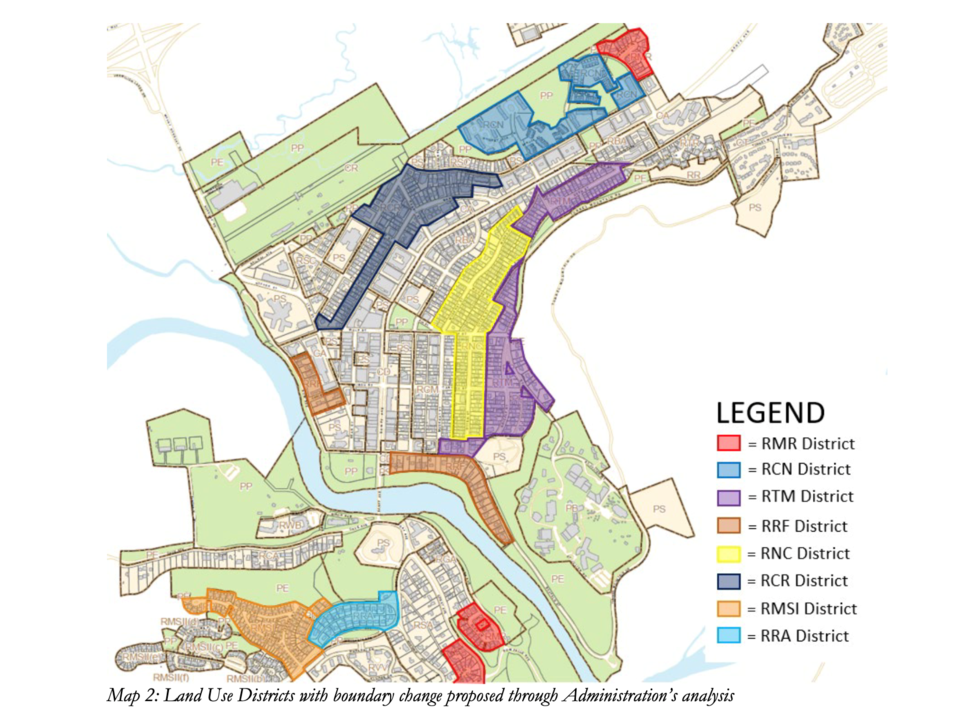BANFF – A bold plan to get rid of residential parking restrictions in Banff that can make development of housing financially unfeasible is one step further down the road to change.
On Monday (March 11), council passed first reading to remove minimum parking requirements from the land use bylaw, which will go to a public hearing at a later date. First reading of another bylaw to change residential land use district boundaries was also passed.
Town of Banff officials say removing parking requirements for residential development is the biggest of the proposed changes council is looking at to encourage construction of much-needed housing.
“Future changes to density will not have the same impact if parking amendments aren’t altered,” said Dave Michaels, manager of planning services for the Town of Banff.
“This fundamental shift, we believe, is needed to realize council’s objectives of achieving those 700 to 1,000 units.”
Currently, there is a legislated requirement for a minimum number of parking stalls when creating new housing in Banff. The requirement has been in place since 1966, first under Parks Canada’s zoning regulations and subsequently the Town of Banff’s land use bylaw.
Michaels said the parking requirements – which add hefty costs to developments and can limit how and what can be built on a property – have proven to be a limiting factor for the development of new residential housing.
He said removing the requirement will allow developers to determine the appropriate level of off-street parking for their properties.
“Our hope is that by removing parking requirements it will allow more flexibility,” said Michaels.
“We still believe people are going to build parking stalls because the market will dictate that, but it will be up to developers to choose.”
Reducing minimum parking requirements is one of five key housing initiatives in Banff’s housing action plan directly tied to Banff’s success in getting $4.66 million from the Housing Accelerator Fund (HAF) – a $4 billion federal initiative to fast-track housing construction.
The others include land use bylaw amendments to increase residential density, creating an accessory dwelling unit incentive program, introducing an e-permitting system, and advancing financial tools and tactics to encourage housing development.
There are several milestones the government will watch for in order for Banff to qualify for the full funding, including a provision the municipality issues building permits for 240 new homes by end of January, 2027.
Mayor Corrie DiManno said there were 20 letters and seven verbal submissions when this issue was talked about at governance and finance committee last year, with only one opposed to eliminating residential parking requirements.
Whether small or large employers, renters, homeowners or those wanting to buy homes, she said they were all urging council to explore innovative solutions to address Banff’s housing crisis.
“The community is not only eager but, frankly, desperate to talk about solutions,” she said.
On Monday, council also passed first reading of a bylaw to amend residential land use districts. A date has not yet been set for the public hearing.
Last year, council directed administration to standardize and simplify development regulations to create high-, medium- and low-density scenarios, applying the same regulations for each density scenario to the existing land use districts.
Administration was also directed to amend land use district regulations to encourage construction of housing and adjust the land use district boundaries so that similar residential areas would be placed together within districts.
The proposal to amend the land use district regulations will be presented at council’s March 25 meeting.
Planners say the boundary adjustments for eight land use districts are proposed either because parts of the district are more suitable to be placed in another district due to their similar character and redevelopment potential, or because the boundary will change to encompass the addition of a part of another district.
“In some cases, there are areas within districts that have a different character or redevelopment potential from other parts of the district and are better suited to being placed in another district,” said Kathleen Gallagher, development planner for the Town of Banff.
Banff & Lake Louise Hospitality Association (BLLHA) voiced strong support for the land use bylaw changes to facilitate more housing.
“It is turning the key to mobilize a housing backlog for a community that has been deficient in its supply since incorporation, and beyond,” said Wanda Bogdane, BLLHA’s executive director.
“It is considering updating layers of dated policy that will empower all types of entities to create the very thing we hear of endlessly that is in most need in our community.”




